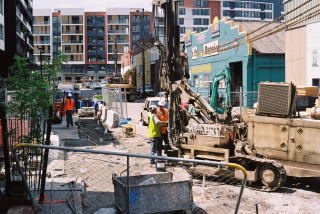GFWAust carried out permeation grouting in silty sands beneath the 330kV mains
The main electrical cable providing 40% of the supply for Sydney CBD comes through Arncliffe and crosses the Cooks River from south of the city. The cable consists of 1600mm2 stranded copper core with a flexible corrugated alluminium sheath, with fluid filled polypropelene laminate insulation, optical fibre temperature sensing and a polyethelylene/Nylon outer cover. The cables are rated at 750MVA continuous or 900MVA cyclic loading.
Following the construction of a new water main in Arncliffe Street in Arncliffe, TransGrid were concerned that the founding sediments beneath the cable had become disturbed and that the cable could potentially settle and bend causing it damage. GFWAust were asked by the geotechnical engineers to determine a grouting method to stabilize the ground with minimum risk to the 330kV cable.
A system of permeation grouting using microfine cements was suggested and successfully trialed before implementing for the entire length of the damaged cables.


